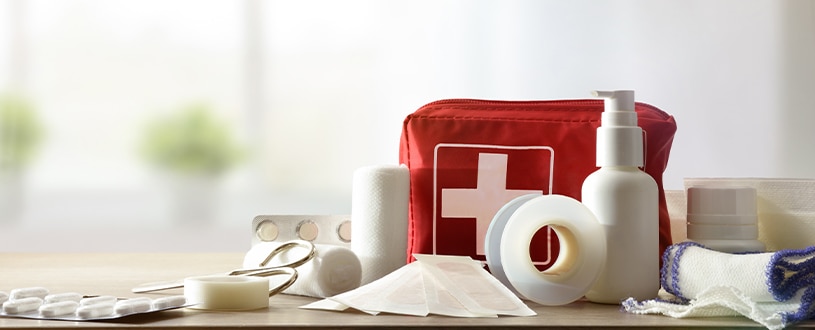Your first aid kit: How Medicare Advantage can help
Be ready for what life throws at you. Use your over-the-counter (OTC) benefit from Medicare Advantage to stock up.

What’s in your first aid kit? If you’re unsure of the answer, or if you’re one of the 44 percent who don’t have one in their home, it may be time to stock up.1
A fully equipped kit is important for all households. Older adults can be vulnerable to severe weather and natural disasters and should also be careful when it comes to life’s little accidents. Common injuries include burns and sprains2 — and some of those can be quickly addressed with the right tools and know-how.
Luckily, your OTC benefits — a perk from most Medicare Advantage plans that pays for your eligible over-the-counter items — can help. Here are some tips to build a kit from scratch or keep the one you have up-to-date.
In this article:
What should you have in a first aid kit?
A well-stocked first aid kit for households and vehicles might include the following:3
- Bandages and absorbent compresses (adhesive bandages, gauze pads, nonstick sterile pads, rolled gauze, adhesive cloth tape)
- A breathing barrier
- Antibiotic ointment packets
- Antiseptic wipe packets
- Pain relief and bite treatment (antibiotic ointment, hydrocortisone ointment packets)
- Packets of baby aspirin (81 mg)
- Instant cold compresses
- Protective gear (nonlatex gloves, face masks, CPR disposable face shield)
- Thermometer (without mercury and glass)
- Tweezers
- Safety pins
- Survival rescue blanket
- Emergency first aid instructions
The kit should be kept in a water-resistant container in a central location, such as in a kitchen drawer away from the stove, sink and any hot appliances. Think somewhere cool and dry — and out of the reach of small children and pets.
It’s a good idea to include emergency phone numbers of family members, health care providers and local clinics, hospitals and urgent care facilities. Keep a small supply of medications you take regularly. You might also consider keeping a second first aid kit in your car in case of any road-related injuries. (Having a spare never hurts.)
What items expire in a first aid kit?
Contrary to popular belief, items in a first aid kit do expire. Remember to check the expiration date on all the items in your kit every six months or as medical needs change.4
In general, if a sterile item such as a bandage is still in its packaging and is still in date, it remains sterile. But if it has expired or been opened, it’s likely no longer sterile and should be thrown away immediately due to the risk of contamination.
Items with rubber or adhesive plastic in them, such as roller bandages and adhesive bandages, also deteriorate over time. If the bandages have expired, you should dispose of them.
All medications, including creams and ointments, have an expiration date. If you no longer have the packaging with that date on it, assume that the product is expired and replace it.5
What are the items you should have on hand?
Like so much of our body, our skin changes as we age. The skin cells of the epidermis, or upper layer of the skin, become thinner and our blood vessels become more fragile.
This all leads to older adults getting bruised or cut more easily and needing more time for cuts and wounds to heal.6 More than one in four adults 65 years and older fall every year, which can lead to injuries like sprains and broken bones.7 Seniors are also more susceptible to serious complications from catching COVID-19, respiratory syncytial virus (RSV) or the flu.
It’s a good idea to have gentle bandages and bandage wrappings in your kit. These might include self-adhering wraps (which won’t stick to the skin), transparent film dressings and nonstick gauze pads. Include shears in the kit to cut away clothing around an affected area as well as instant ice packs to alleviate the pain. And finally, think about including medical-grade face masks.
Remember — having a first aid kit on hand doesn’t mean you shouldn’t contact a medical provider when you’re hurt. But it can help you care for yourself until you can see them.
What first aid items does the OTC benefit cover?
The good news is that most of the items listed above are covered by the Medicare Advantage OTC benefit.8 Each program usually covers different types of bandages, face masks, butterfly closures, rubbing alcohol wipes, cold compression wraps and oral thermometers.
For a complete list of items that are covered by your plan, refer to the catalog that you should have received with your welcome pack. And make sure you know how to use your OTC benefit at CVS® stores.
This content is for informational purposes only and is not medical advice. Consult your health care provider before taking any vitamins or supplements and prior to beginning or changing any health care practices.
-
-
-
-
-
-
-
-
-
*FOR OVER-THE-COUNTER BENEFITS AT NO ADDITIONAL COST: Over-the-counter (OTC) allowance benefits are included in select Medicare Advantage and Medicaid plans. The allowance may only be applied to select OTC products. Allowance amount may vary by plan. Customer may be responsible for the cost of any items not covered by their plan or that exceed their allowance amount. Check with your health plan provider for more details.
